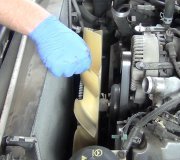Ah yes -- "orange sludge" rears it's ugly head once again. That is the effect of GMs' version of Dexcool (the orange coolant). Your radiator is new so you shouldn't want any of the sludge that is in the engine to break free and clog the new radiator and /or the water pump - (and it will). To be honest, it is only a matter of time before you need to replace the lower intake manifold gaskets, so I would just go ahead and remove the water pump - flush the crap out of the system with a high pressure hose. Then remove the soft plugs and flush again the same way. Most of the sludge should come out of the soft plug holes - and this will totally flush the entire engine block -- but not the heads. The heads is where this sludge really causes problems - and probably yours. The build up is usually most around the number 7 and 8 cylinders (the back of the engine). The best way to clean up the heads is to remove them -- but you can also just remove the lower intake manifold (which will need to be done soon anyway) and very carefully clean and flush out the heads that way. Then replace the lower intake gaskets (and be sure to use the new, more expensive, style gaskets with the metal inserts to prevent over torqueing).
A radiator flush may or may not do the trick.I know it seems extreme and it is a lot of work, but if the blockage gets worse, it can distort the cylinder bores (from uneven heat dissipation) and cause the head gasket or even the piston rings to fail prematurely. Be sure to put new soft plugs in the block useing gray silicone - and allow at least a day before you put coolant in the engine (this will allow the soft plugs to properly seal). Use Prestone Dexcool coolant - not GM Dexcool. Mix it properly or just buy it premixed.
The scan tool is a good tool for the home mechanic, but it cannot tell you where the timing of the engine is at. It just tells you the spark advance or retard degree from the base timing point. The base timing point (which is +or- 1 degree of TDC) is set by adjusting the distributer and using a GM Tech One scan tool. Timing lights will not work. These scan tools are not usually not available outside of a dealership and they are around $15000.00 bucks. Anyway, I don't think it is a timing issue -- it probably is a blockage in the cooling system caused by GM Dexcool (the orange coolant). BTW - google 'gm dexcool settlement'. You may be suprised.
Monday, January 25th, 2010 AT 8:16 PM


